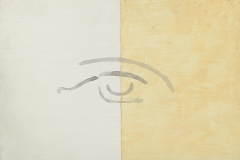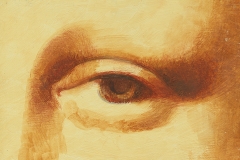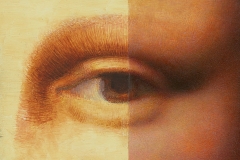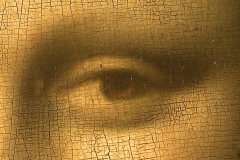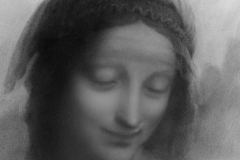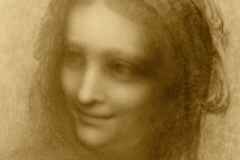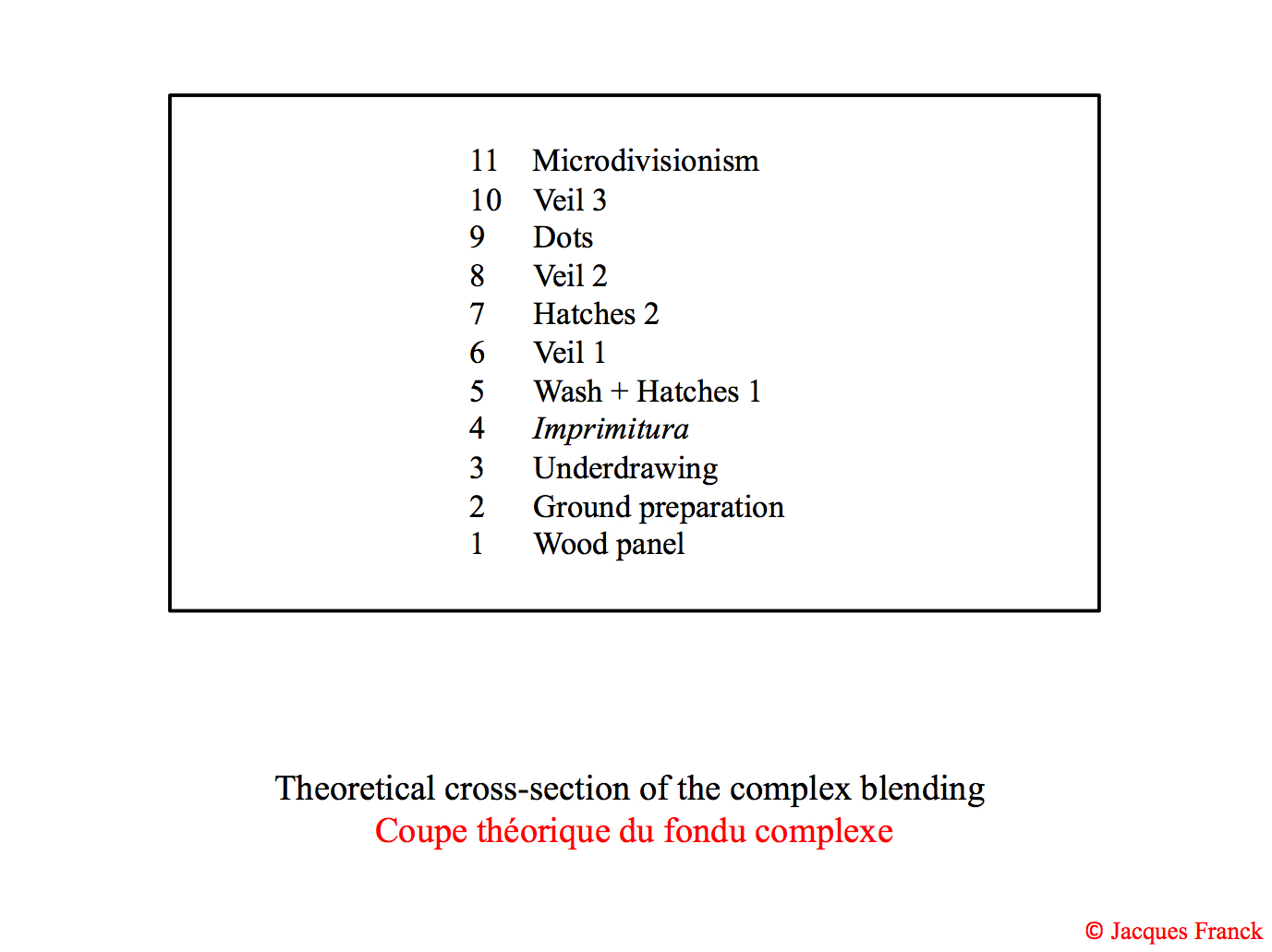Introduction
Much research, most of which scientific, has been undertaken in the past twenty years to explain the unusual, hermetic flesh technique as seen in Leonardo’s late paintings, the Mona Lisa included. Yet, before that of Jacques Franck’s, none has addressed the issue from within methodically, in other words according to painterly criteria. Because the above Leonardo works are paintings and, as such, needed to be studied from an artist’s esthetic-technical point of view : there is no best way than critical copy-work to closely understand the specific processes and stages whereby a given paint film was elaborated. Many hypotheses have been put forth through the years to explain Leonardo’s complex blending, a technique not to be confused with his simple blending, a traditional process in which the paint film was handled both with the brush and the master’s fingers in order to obtain soft focus effects. But no satisfactory, strongly resemblant copy of the Mona Lisa or of the Saint Anne was ever produced based on these speculations. In this respect, Franck’s Leonardo copies have achieved the sole fully convincing visual demonstration of Leonardo’s true painterly method. It is therefore no surprise that evidence of this method was found by Franck finally, many years after his first publications on the subject. An outcome telling us much in that field of research : there is a great difference between the belief that one understands a picture’s making by just looking at it with a connoisseur’s eye, and the actual technical knowledge acquired through years and years of experimental practice thanks to which that making can be understood and explained pertinently. Learning to draw and paint in the classic tradition remains a fabulous means to improve one’s eye judgment on Old Master productions.
Au titre de la sensibilisation que nous faisons depuis 30 ans sur la nécessité que les historiens d’art et les scientifiques chargés de l’expertise des peintures aient un minimum d’information sur la pratique des peintres d’expression classique, nous communiquons ci-dessous à nos lecteurs les deux premiers chapitres du « Prologue to Further Thoughts II » que nous venons de publier sur le site d’ArtWatch UK Online.
I – Common confusion between connoisseurship and the knowledge of art acquired through practice
When a painter trained in the academic/classical tradition – and being, therefore, an experienced and skilled copyist – visually examines an old master painting, a mental engagement occurs which instantaneously brings to mind sequenced images representing the artistic and technical process followed by the creator, a process that can easily be identified because of a familiarity gained through years of practice. A similar phenomenon occurs when musicians read a score without playing it: they can “hear” the written sounds and melodies while visualizing the technical and musical means necessary to their own performances. However, although they usually deal with old master expertise, neither art historians nor scientists practice the arts of drawing and painting, bar in exceptional cases. For that reason, their visual appraisal of the specifically technical elements presented in a painting are formulated on no sure and practical knowledge of the various artistic and technical gestures whereby they were produced. Such experts, being so remote from the creative process, can only grasp artistic, technical and material realities through their imagination and whatever objective data might have been supplied by scientific imaging and laboratory tests. In other words, such specialists are strangers to what is at the heart of creation, to its intimacies, shall we say, and they cannot but confound their own imagined and partial perceptions with the realities of the creative process itself. That so very few art historians or museum scientists recognise the impossibility of knowing what art is really about without having engaged in making it is exclusive to the visual arts today. Such handicaps could never arise in the world of music because no sensible person thinks serious musical knowledge can be obtained without years of training and the steady practice of a specific instrument. In the visual arts this extraordinary shortcoming creates maximal risks of errors: in matters of art attribution, the vital distinctions between one creative hand and another are too subtle; in matters of conservation, the master’s art and techniques are commonly misunderstood – and nowhere more so than with that of Leonardo da Vinci. In no small measure, the modern-day visual art malaise is product of a system in which the artist – the party holding a unique expertise and insight – is granted no institutional recognition when precisely such knowledge, purely factual and not theoretical, is irreplaceable in art expertise.
That is why, as early as 1998 in my essay on artistic training published in Coré, a conservation review edited by the French section of the IIC, I recommended that students in art history should be trained in art and acquainted with the elementary notions of both traditional drawing and painting in order that their approach to the discipline lies on pragmatic specialized grounds rather than on vague, unverified concepts in matters of art making, as are exemplified below [1].
II – Disturbing ignorance
There of course exist a number of art specialists whose visual acuity and methodology of research are excellent, but they are getting fewer and fewer (for reasons not examined here). Sadly, tangible evidence exists also of the ignorance of some leading experts regarding the elementary grounds of traditional painting techniques inherited from the Renaissance, to which Leonardo’s art practice belongs. On that particular issue, for instance, in a 2019 documentary movie broadcast world-wide, an otherwise well-meaning Louvre Museum curator interviewed about Leonardo’s sfumato technique provided a staggering explanation that revealed an ignorance of the fact that, in the oil process, when it is laid on the support (canvas or wood typically), the paint material itself (pigments + binder) should first be diluted to a suitable degree with a fluxing agent – i.e. a solvent (turpentine in the case in point) [2]. The presented extravagant hypothesis in question was addressing the ravishing, subtle, flesh sections in Leonardo’s Louvre St. Anne and the Mona Lisa, on a conviction that pigments and oil alone were used. In terms of practice, it amounts to an insolvable technical problem inasmuch as the rheology of the presumed material to be handled for achieving impalpable effects like those seen in the Louvre Leonardos is a major impediment: such a sticky and oily paint is, structurally, far too unruly to be appropriate for that kind of ultra-delicate work. Thanks to my own researches – now confirmed by Philippe Walter and Laurence de Viguerie (see Further Thoughts II) – it is an established fact that Leonardo used to superimpose in the flesh sections of the above-mentioned works numerous microlayers of very liquid paint according to material principles close to the watercolour technique, except for the fact that, in this particular case, the fluxing agent was turpentine and not water. In truth, our museum curator should have known better: it is an obvious fact, noticeable by any ordinary museum visitor, that, during the Renaissance until the late 19th century, the most part of paintings was executed using diluted paint as testified by the flat, even sections still observable in them to date. The zones of the compositions, however limited in terms of surface, in which pure oil was added to the paint are the glazed ones, and the sections where non diluted, thick pasty paint, is encountered are those ones executed in impasto, a technical process which was notably employed for the treatment of highlights and for the demonstration of the spontaneity and virtuosic quality of the artist’s brush. To be more precise, it should be added that no stricto sensu glazes (transparent layers) were used then for modelling in the flesh sections, but, instead, thin veils of translucent paint [3]. Misinterpretations regarding art practice such as reported here are commonplace in the field of connoisseurship and, in themselves, have no a priori serious importance. Yet, in the case of Leonardo’s late works it has one indeed because, in the event of cleaning, their very low oil-content paint film is at far greater risk under solvent action. [4]. It certainly is not advisable, therefore, that misleading information should be in circulation in the international museum sphere about the technique used for the making of such universal masterpieces. Erroneous preconceived views should never sanction or influence restorations.
Critical Reconstitution in oils of Mona Lisa’s Proper Left Eye
© Jacques Franck
Critical Copies After Leonardo da Vinci
1. Jacques Franck, drawn copy after the Louvre 2. Jacques Franck, free copy in oils after the St Anne St Anne in the the Burlington House Cartoon
© Jacques Franck
mkmkl
ABOUT THE COPIES
mkmkl
The first, drawn in colour pencils after St Anne’s head in the Louvre panel painting was made as a graphic-painterly demonstration to student-restorers learning how to do particularly skilled inpainting on the Old masters. Copying with colour pencils was an early stage of their training. Given that the ultra thin upper layers of Leonardo’s complex blending were partly executed by means of microdivisionism, obtaining micro-strokes either with the highly-sharpened end of a colour pencil or with the highly sharp end of a very fine brush responds to one and a same technical principle. Had Leonardo used colour pencils to draw St Anne’s head, it might be said that the end result would have been rather like mine but with added genious.
The second copy was freely made in oils after the unfinished head of St Anne in the Burlington House Cartoon (The National Gallery, London). That particular exercise served as a base for my subsequent demonstration since the binder used in Leonardo’s paintings was siccative oil.
In 1995 it appeared that the X-radiograph of copy n° 2 generally resembled the X-radiographs of the Louvre Leonardos of his late period, which have a typical evanescent aspect with low contrast and density. Actually, the Mona Lisa, the St Anne and St John-the-Baptist are works that were painted using complex blending. In order to make this technique clear, see below the diagram of a theoretical cross-section of a paint layer built up by means of complex blending. In addition, the small panels above show the making of the Mona Lisa‘s own left eye step by step when using complex blending.
The panel demonstrations are informed by data observed on original Leonardos concerning the preparation and the ground layers to which is combined the rediscovered technique of complex blending. These elements were published in 2006 on the occasion of the La Mente di Leonardo exhibition held at the Uffizi Gallery in Florence.
mkmkl
« Dear Mr. Franck, […] Thank you very much for your publications and dossiers : they are most interesting. Your research on Leonardo’s works and technique is fascinating, and your copies after his works are stunning. » (Federico Zeri, Art Historian, Visiting Professor at Harvard University and Columbia University, 28th April, 1994) ; « Dear Mr. Franck, […] I am fascinated by your research on Leonardo’s way of painting. I hope that your discoveries will prevent Museums and Restorers from touching Leonardo’s works. » (Federico Zeri, 4th July, 1997).
« La première fois que j’ai vu des dessins de Jacques Franck, j’étais vraiment troublé […] Pendant quelques instants, j’ai cru qu’ils venaient d’une autre dimension ! C’était comme voir des dessins de Léonard lui-même. Jacques Franck est le seul, à ma connaissance, à pouvoir les reproduire avec une telle ressemblance. C’est vraiment un peintre de la Renaissance, il y a du Léonard dans son esprit. » (Carlo Pedretti, Art Historian, Emeritus Professor, Head of The Armand Hammer Center for Leonardo Studies at UCLA, interview of the 25th October 2012, in Vinci, French translation by Réjane Éreau ».
« Dear Jacques, […] First, let me compliment you for the competence you showed me in understanding (probably for the first time ever) Leonardo’s technique and specifically the « sfumato ». I was very impressed by your exceptional skill in reproducing the sfumato and also by the quality of the art works you showed me. I have never seen anything so accurate in reproducing the smooth transition from light to dark as you have succeeded in doing. I believe your book would most probably be the very first contribution to understand Leonardo’s technique as a painter. » (Dr. Engineer Maurizio Seracini, Director of the scientific laboratory Editech, Florence, Italy).
Le « fondu complexe » de la Joconde, reconstitué, expliqué et démontré par la technique, l’histoire et la science » (Explaining Leonardo’s « complex blending » sfumato technique as used in the Mona Lisa and confirmed by painterly technique, history and science)
Parmi les nombreuses énigmes de la Joconde, celle de la technique d’exécution tient un rôle essentiel dans la fascination qu’exerce le portrait sur les foules. On observe en effet dans les chairs un travail délicatement enveloppé, d’aspect brumeux, sans autre exemple dans la peinture occidentale. Cette technique, inventée par Léonard de Vinci, est dite du sfumato, mot italien qui signifie : enfumé, vaporeux.
Dans le visage de Monna Lisa, Léonard a élaboré une couche peinte extraordinairement mince, lisse, où aucun signe révélateur de la technique employée ne se décèle. Ce constat, effectué au Laboratoire du musée du Louvre dans les années 1950, reste d’actualité : un demi-siècle plus tard, en 2004, de nouveaux examens l’ont confirmé.
Devant l’énigme du sfumato, les historiens n’ont pas eu plus de succès que les scientifiques. Les abondants écrits théoriques de Léonard sur l’art de peindre n’ont livré sur le sfumato aucune information explicite a priori, c’est-à-dire accessible à des chercheurs n’ayant jamais étudié ni pratiqué les techniques picturales anciennes.
Seule une expérimentation par la copie pouvait conduire à la solution. Historien d’art et peintre de formation classique, en copiant Léonard Jacques Franck a réalisé un véritable travail de reconstitution critique, dont les principales observations ont été publiées sur le plan international entre 1993 et 2014. Le bilan de cette recherche s’articule à ce jour en sept étapes principales.
- 1990 : production de copies d’aspect très proche des originaux de Léonard (cf. Franck, 1993/1 et Franck, 1993/2) ;
- 1995 : l’une d’elles (see copy n° 2 above) présente aux rayons X une étroite analogie avec les radiographies de la Joconde et de la Sainte Anne du Louvre (cf. Franck, 1997/1 et Franck, 2006-2007) ;
- 1997 : publication d’une argumentation scientifique modélisant la problématique structurelle du sfumato (cf. Franck, 1997/1 et Franck, 2006-2007) ;
- 2003 : publication de traces d’exécution significatives jamais étudiées auparavant et observées sur deux études de draperie de Léonard conservées au Louvre (n° 2255 et n° 2257) (cf. Franck, 2003 et Franck, 2006-2007) ;
- 2006 : découverte et publication d’éléments décisifs sur la micro-division de la couleur dans la peinture ancienne, donnant une vision nouvelle des sources historiques et techniques du sfumato léonardien (cf. Franck, 2006-2007 et Franck, 2014) ;
- 2009-2011 : découverte dans la Joconde de nombreuses micro-couches par fluorescence des spectres de fluorescence X sur le visage de la Joconde (travaux de L. de Viguerie et de P. Walter confirmant l’hypothèse de « voiles » superposés émise dans Franck 1993/ 2, Franck, 1997/1 et Franck, 2006-2007) ;
- 2012 : découverte de la pratique courante de micro-divisionnisme dans des copies de l’atelier de Léonard et sous sa supervision (Sainte Anne des Offices Inv. n° 737 et Joconde du Prado) (cf. Franck, 2014).
L’intervention de Jacques Franck dans l’exposition La Mente di Leonardo à la Galerie des Offices en 2006 part de l’hypothèse, émise par ce spécialistes dès 1990, que Léonard a utilisé deux techniques de fondu différentes, quoique complémentaires pour réaliser les dégradés impalpables de la Joconde. Les copies du chercheur ont montré que l’association de ces deux techniques permettent effectivement d’atteindre des effets analogues à ceux de Léonard.
L’opinion répandue jusqu’à présent (mais sans preuve ni étude appropriée) était que Léonard aurait eu recours au fondu simple, une technique courante de fusion matérielle des couleurs employée en peinture pour donner la sensation du relief, ce qui est l’objectif principal du sfumato. Les travaux de Jacques Franck ont toutefois révélé que le fondu simple était un moyen inadapté pour parvenir aux subtilités de la Joconde. D’où le fait que les copies de Jacques Franck sont les seules, historiquement, qui reproduisent à l’identique l’aspect du sfumato léonardien.
En réalité la solution se trouve dans le fondu complexe, technique extrêmement élaborée caractérisée par la superposition de microcouches pigmentées translucides (voir Critical Reconstitution ci-dessus, stage 4, et coupe théorique du fondu complexe ci-dessous) :
- unies et semblables à des voiles pour les unes,
- microdivisées pour les autres, c’est-à-dire composées de minuscules touches pouvant atteindre 1/20e à 1/30e de millimètre en phase finale (voir la coupe théorique ci-dessous)
Entre 2009 et 2011, la science a pu démontrer la partie de l’hypothèse de Jacques Franck selon laquelle le sfumato léonardien est une stratification picturale formée de multiples microcouches translucides (voir sur ce point L. de Viguerie, Propriétés physico-chimiques et caractérisation des matériaux du « sfumato », thèse de doctorat de sciences de l’Université Pierre et Marie Curie, Paris VI, 2009 ; L. de Viguerie et al., « Revealing the sfumato technique of Leonard da Vinci by X-Ray Fluorescence spectroscopy », Angewandte Chemie, XLIX, n° 35, 2010, p. 6125-6128 ; P. Walter, L. de Viguerie, J. Castaing, « Appareils portables pour l’analyse des oeuvres d’art aux rayons X », Images de la physique, CNRS, 2011, p. 82 (http://cnrs.fr/publications/imagesdelaphysique/Auteurs2011/12_Walter.htm. Consulté le 4 février 2014).
Enfin, la récente exposition au musée du Louvre La Sainte Anne l’ultime chef-d’oeuvre de Léonard de Vinci a été l’occasion de réunir pour la première fois les copies et variantes d’atelier de la Vierge, l’Enfant-Jésus et sainte Anne nouvellement restaurée, ainsi qu’une copie très intéressante de la Joconde, conservée au Prado. Exécutées sous la direction de Léonard et bien connues des spécialistes, ces oeuvres n’avaient pas encore fait l’objet d’études approfondies en ce qui concerne les pratiques picturales en vigueur dans cette grande bottega. Leur examen visuel a permis de confirmer un aspect essentiel du métier raffiné de Léonard : l’emploi de vélatures micro-divisées (fondu complexe) destinées à la réalisation de subtilités exceptionnelle, dans les carnations des années 1500. Cruciale, cette observation valide une nouvelle fois, tout en les complétant, les travaux minutieux de Jacques Franck sur la question.
